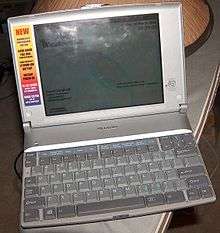Handheld PC

A handheld PC, or H/PC for short, is a computer built around a form factor which is smaller than any standard laptop computer. It is sometimes referred to as a palmtop computer. The first hand-held device compatible with desktop IBM personal computers of the time was the Atari Portfolio of 1989. Other early models were the Poqet PC of 1989 and the Hewlett Packard HP 95LX of 1991. Other DOS-compatible hand-held computers also existed. Some handheld PCs use Microsoft's Windows CE operating system, with the term also covering Windows CE devices released by the broader commercial market.
Handheld PCs were discontinued in the early 2010s as the market shifted to smartphones and tablets (with the exception being the iPod Touch line by Apple Inc.).
Windows CE
The Handheld PC was a hardware design for personal digital assistant (PDA) devices running Windows CE. It provides the appointment calendar functions usual for any PDA. The intent of Windows CE was to provide an environment for applications compatible with the Microsoft Windows operating system, on processors better suited to low-power operation in a portable device. Originally announced in 1996, the Handheld PC is distinct from its more recent counterparts such as the Palm-Size PC, Pocket PC, or smartphone in that the specification provides for larger screen sizes as well as a keyboard.
To be classed as a Windows CE Handheld PC, the device must:[1]
- Run Microsoft's Windows CE
- Be bundled with an application suite only found through an OEM Platform Release and not in Windows CE itself
- Use ROM
- Have a screen supporting a resolution of at least 480×240
- Include a keyboard
- Include a PC card slot
- Include an infrared (IrDA) port
- Provide wired serial and/or Universal Serial Bus (USB) connectivity
Over time, these standards were routinely breached by manufacturers. For instance, HP's first displays' widths were more than a third larger than that of Microsoft's specification. Soon, all of their competition followed. Examples of Handheld PC devices are the NEC MobilePro 900c, HP 320LX, HP Jornada 720, and Vadem Clio.
Microsoft stopped developing for the Handheld PC in 2000, instead focusing development on the Pocket PC and Windows Mobile. However, compatible hardware continued to be produced for many years afterwards. HP and Sharp both discontinued their Windows CE HPCs in 2002, while NEC was last to leave the market in 2005. However, some manufacturers abandoned the format even before Microsoft did, such as Philips and Casio.
Other handheld PCs may not use Windows CE. Windows CE devices which match all of the hardware requirements of the H/PC specification but lack a keyboard are known as Windows CE Tablet PC or Internet tablet devices.
See also
References
- ↑ Tilley, Chris (2001-02-18). "The History of Windows CE: Windows CE 1". HPC:Factor. Retrieved 2007-04-20.
External links
| Wikimedia Commons has media related to Handheld PC. |